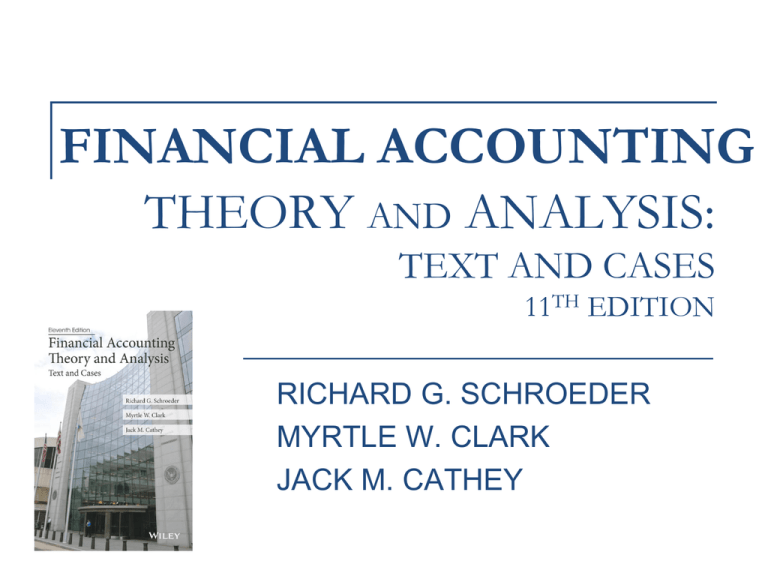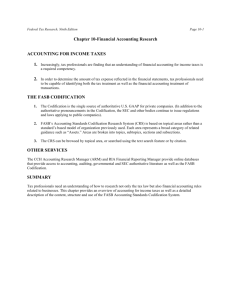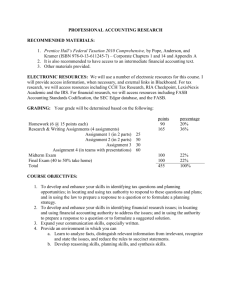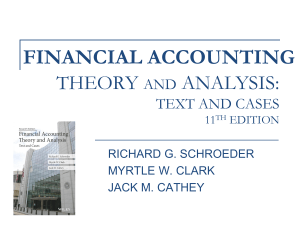
FINANCIAL ACCOUNTING
THEORY AND ANALYSIS:
TEXT AND CASES
11TH EDITION
RICHARD G. SCHROEDER
MYRTLE W. CLARK
JACK M. CATHEY
CHAPTER 1
THE DEVELOPMENT OF
ACCOUNTING THEORY
Introduction
What is theory?
Webster defines theory as:
“Systematically organized knowledge, applicable in a relatively wide
variety of circumstances, a system of assumptions, accepted principles
and rules of procedure to analyze, predict or otherwise explain the
nature of behavior of a specified set of phenomena.”
Normative theory
Positive theory
Why is the development of a general theory of
accounting important?
Allocating scare resources
What is the relationship of accounting research
to accounting theory?
Various theories of accounting will be discussed in
Chapter 4
THE EARLY HISTORY OF
ACCOUNTING
Denise Schmandt-Besserat
Origins of writing are actually found in counting.
Pieces of fired clay in Middle Eastern archeological sites.
Tokens comprised an elaborate system of accounting that was used
throughout the Middle East from approximately 8000 to 3000 B. C.
Each token stood for a specific item
Used to take inventory and keep accounts
Other accounting records dating back several
thousand years have been found in various parts of the
world.
These records indicate that at all levels of development, people desire
information about their efforts and accomplishments.
THE EARLY HISTORY OF
ACCOUNTING
For example the Zenon Papyri
Who was Zenon?
Information about the construction projects, agricultural
activities, and business operations of the private estate of
Apollonius for a period of about thirty years during the third
century B.C.
Renaissance
Italians pursuing trade and commerce needed records
Fra Luca Pacioli
THE EARLY HISTORY OF
ACCOUNTING
The evolution of joint ventures into ongoing
businesses
Caused need for external financial reporting
The impact of the industrial revolution and the
progressive movement
Widespread speculation in the securities markets, watered
stocks, and large monopolies that controlled segments of
the U.S. economy.
1900 report suggested that independent public accounting
profession should be established to curtail observed
corporate abuses.
THE EARLY HISTORY OF
ACCOUNTING
The concept of capital maintenance
Viewed as a way to curb corporate abuses
The accountant as a protector of business interests
American Institute of Accountants (AIA)
American Association of the University Instructors in
Accounting
ACCOUNTING IN THE UNITED
STATES SINCE 1930
Because of fear of government intervention
What caused formation of SEC?
Meetings between NYSE and AIA
AAA
SEC
Securities Act of 1933
Securities Exchange Act of 1934
Difference between public and private sector formulation of
accounting principles
ACCOUNTING IN THE UNITED
STATES SINCE 1930
1936 - 1938
SEC: internal debate about whether it
should develop accounting standards.
1938
Accounting Series Release (ASR No. 4)
SEC allowed private sector to set accounting principles
Reports filed with SEC must be prepared in accordance with accounting principles
that have “substantial authoritative support{.
A Statement of Accounting Principles
Sanders, Hatfield & Moore
Because accounting profession did not think it had time to develop
theoretical framework of accounting
“Do what you think is best.”
American Institute of Certified Public Accountants
(AICPA)
Formed in 1936
Influence on development of accounting theory
Committee on Accounting Procedure
Accounting Principles Board
Financial Accounting Standards Board
Each has issued pronouncements
Have become primary source of today’s generally
accepted accounting principles
Committee on Accounting Procedure (CAP)
Formed in 1936
Accounting Research Bulletins (ARBs)
Professional accountants
Pronouncements
Did not dictate mandatory practice
Received authority only from general acceptance
ARBs consolidated in 1953
Accounting Terminology Bulletin NO. 1, “Review and Resume”
and ARB No. 43
ARB 44-53 published 1953 – 1959
FASB Accounting Standards Codification (Discussed later in the
chapter) includes recommendations of these bulletins that
have not been superseded
THE ACCOUNTING PRINCIPLES
BOARD (APB)
CAP criticized
Methods of formulating accounting principles didn’t arise
from research based on theory
Acting in piecemeal fashion & Issuing inconsistent standards
Resulted in APB
Formation and structure
Types of pronouncements
APB Opinions
Accounting for the investment
tax credit (1961)
APB Opinions 2 & 4
Rule 203
THE ACCOUNTING PRINCIPLES
BOARD (APB)
Criticism of the APB
Independence of members
Structure
Members had full-time responsibilities elsewhere that could influence
views
“Big 8” automatically awarded 1 member
Usually 5 or 6 other public accountants on board
Response time
Part-time members not able to investigate
and resolve emergency issues in timely
manner
THE FINANCIAL ACCOUNTING
STANDARDS BOARD
Because of growing criticism of APB
1971: Board of Directors of AICPA
appointed 2 committees:
The Wheat Committee
The Trueblood Committee
How to establish accounting principles
Objectives of financial statements
The FASB was established
Structure of the FASB
Appoint and
fund
------|
|
|
Financial
Accounting
Foundation
Govern
Board of
Trustees
Appoint
Appoint and
fund
Financial
Accounting
Standards
Advisory
Committee
(approx.
20 members)
Admin.
Staff
Financial
Accounting Appoint
Standards
Board
( 7 members)
Research Staff
Task Forces
of the
Standards
Board
Electors
FASB
Mission – establish standards
Types of pronouncements
Statements of Financial Accounting Concepts
Statements of Financial Accounting Standards
Interpretations
Technical Bulletins
FASB
Emerging Issues
Standards Overload
Too many standards
Standard setting as a political process
Lack of timely guidance
Some users found that best way to influence
formulation of accounting standards is to attempt
to influence standard setters
Example: SFAS No. 123 and 123R
Economic Consequences
GAAP
Evolution of phrase:
Changed wording of auditor’s certificate brought about by
meetings between NYSE and AIA
The APB’s definition
The Auditing Standards Executive Committee’s definition
“present fairly…in conformity with generally accepted accounting
principles:
No singular reference source exists for all principles
Makes general acceptance of a specific principle
difficult
SAS 69: determining acceptance of a
specific principle is difficult
SFAS No. 162
Hierarchy of GAAP
Four levels
A
B
FASB codification project reduced
this to 2 levels:
C
D
Authoritative
Not authoritative
The FASB’s Accounting Standards Codification
Hundreds of accounting standards promulgated by
several different accounting standard setters.
Accounting standards had evolved to the point that
professionals could not keep up.
September, 2004: the FAF Trustees approved funding
for the FASB’s codification and retrieval project
The FASB’s Accounting Standards Codification
June 2009
FASB announced Codification
would be single source of all
nongovernmental US GAAP
effective 9/15/09.
Involved following steps:
1.
2.
Restructure all U.S. GAAP literature by
topic into a single authoritative
codification.
Modify the standard-setting process to
focus on updating the codification.
The FASB’s Accounting Standards Codification
Reasons for codification
Researching multiple authoritative sources
complicated research process
FASB, EITF, AICPA & SEC literature
FASB ASC contains all current
authoritative accounting literature
If guidance is not specified, first source to
consider is accounting principles for similar
issue with a source of authoritative GAAP
Nonauthoritative guidance from other sources
may be considered if similar transactions aren’t
discovered in GAAP.
THE ROLE OF ETHICS IN
ACCOUNTING
The public accountant as a
watchdog
What is basic conflict of interest
facing public accountants?
Accounting in Crisis – The Events of
the Early 2000s
Enron and the Accounting Scandals
“Special-purpose entities” (SPEs)
Now termed variable interest entities (VIEs)
Purpose:
Access capital
Hedge risk
Allowed company to increase financial leverage
and return on assets without reporting debt on
balance sheet
Losses were kept off Enron’s books
Enron filed for bankruptcy and stock became
virtually worthless.
Accounting in Crisis – The Events of
the Early 2000s
1.
Two major changes in the accounting profession have
taken place in the wake of the accounting scandals:
Arthur Andersen
formerly one the Big 5 audit firms
has gone out of business
Sarbanes-Oxley Act
2.
President Bush signed into law July 2002
imposes a number of corporate governance rules on publicly traded
companies (Discussed in chapter 17)
International Accounting Standards
The concept of harmonization
The IASB
The IASB’s objectives:
1.
2.
To formulate and publish in the public interest accounting
standards to be observed in the presentation of financial
statements and to promote their worldwide acceptance and
observance
To work generally for the improvement and harmonization
of regulations, accounting standards, and procedures
relating to the presentation of financial statements.
41 Statements of Accounting Standards and 13
Statements of Financial Reporting Standards to date
End of Chapter 1
Prepared by Kathryn Yarbrough, MBA
Copyright © 2014 John Wiley & Sons, Inc. All rights reserved.
Reproduction or translation of this work beyond that permitted in
Section 117 of the 1976 United States Copyright Act without the
express written consent of the copyright owner is unlawful. Request
for further information should be addressed to the Permissions
Department, John Wiley & Sons, Inc. The purchaser may make backup copies for his/her own use only and not for distribution or
resale. The Publisher assumes no responsibility for errors,
omissions, or damages, caused by the use of these programs or from
the use of the information contained herein.




